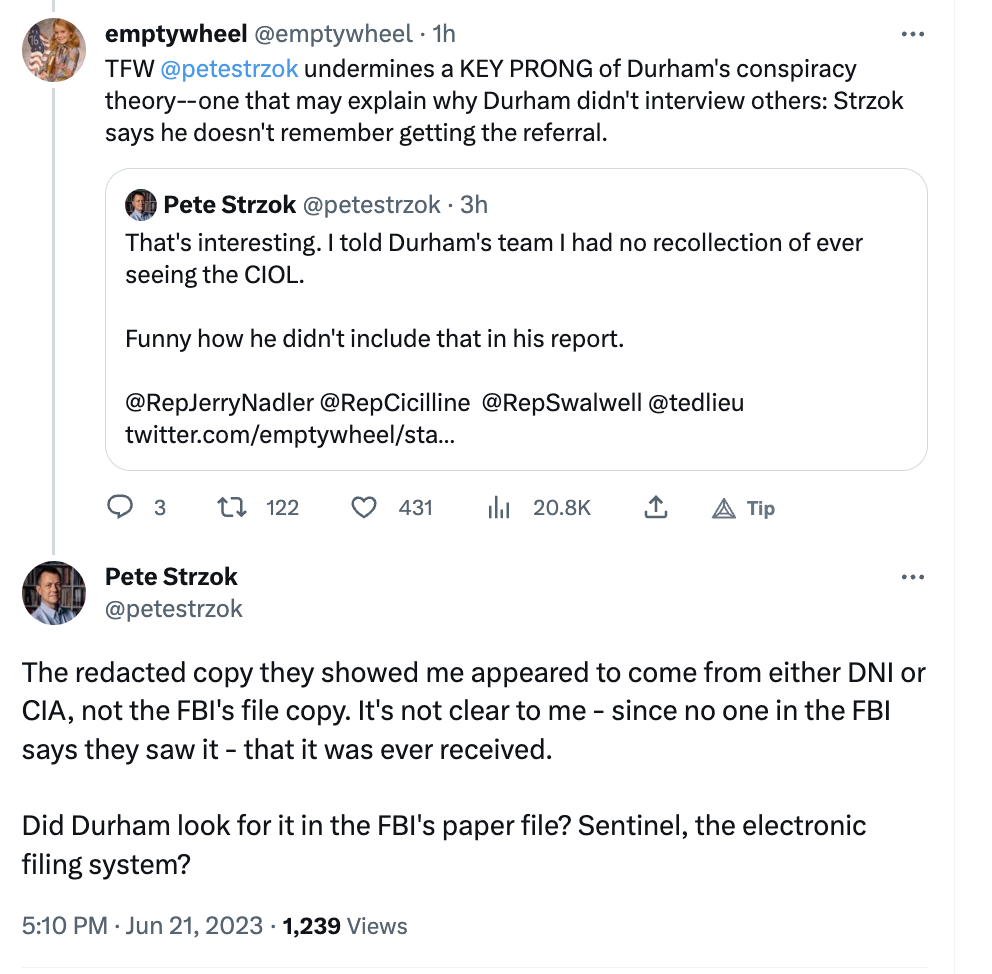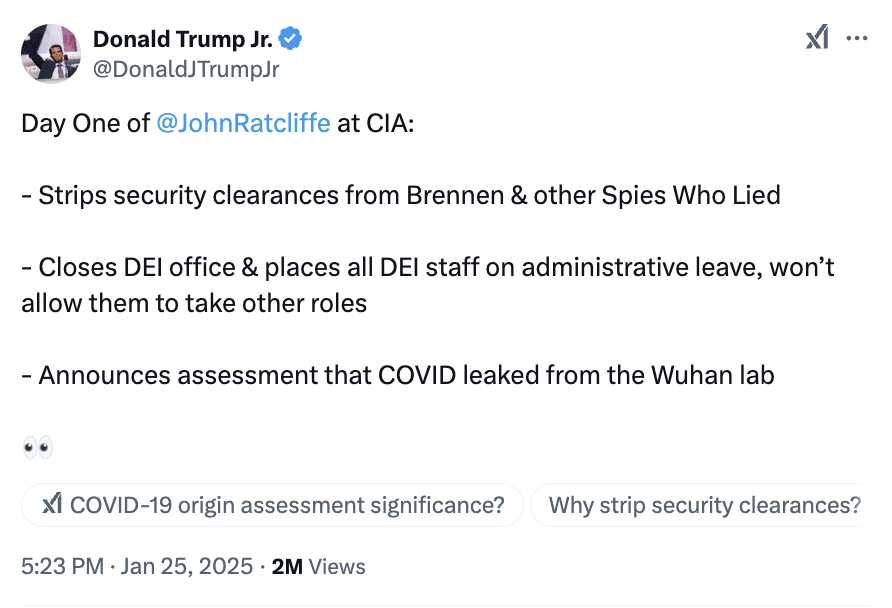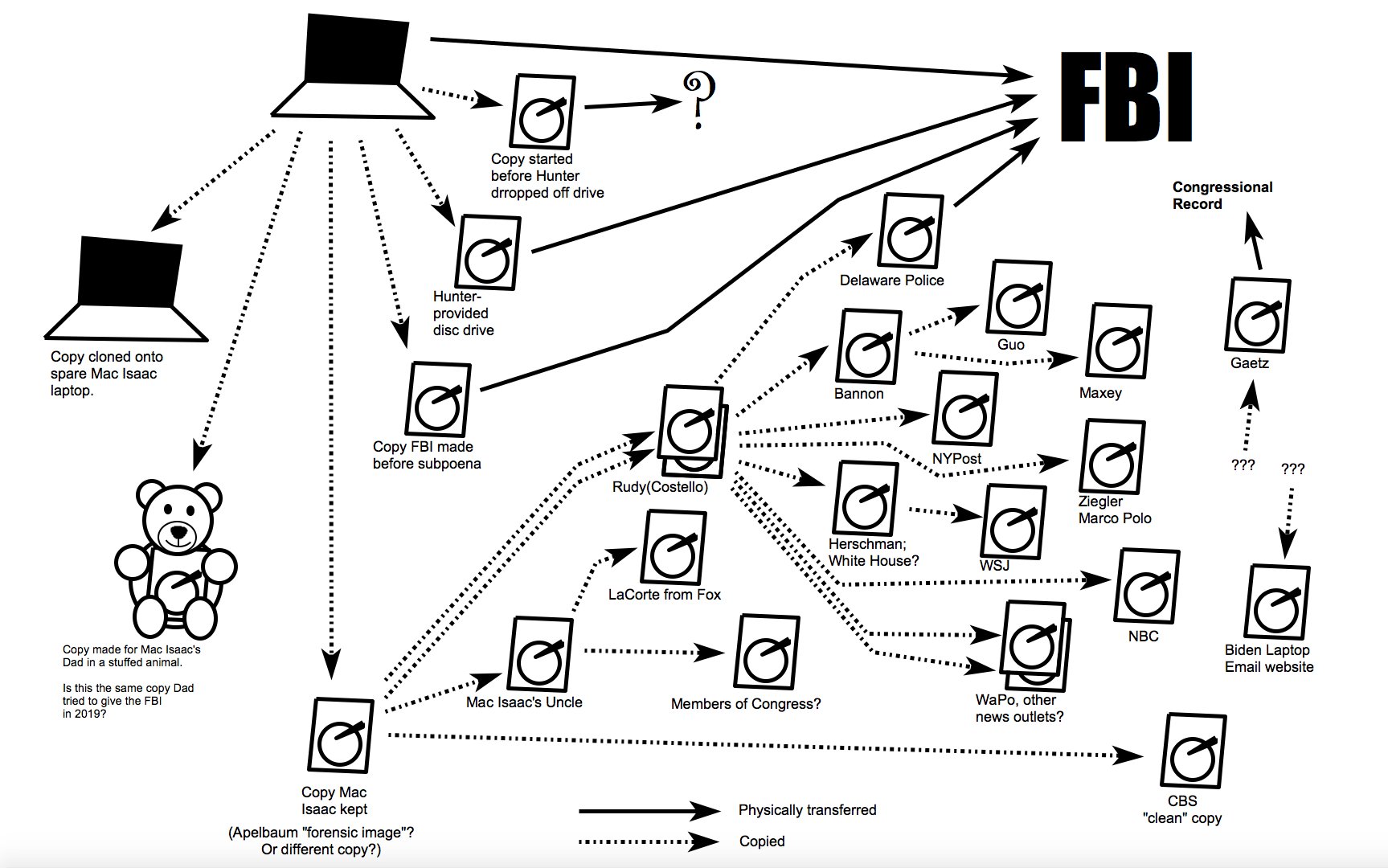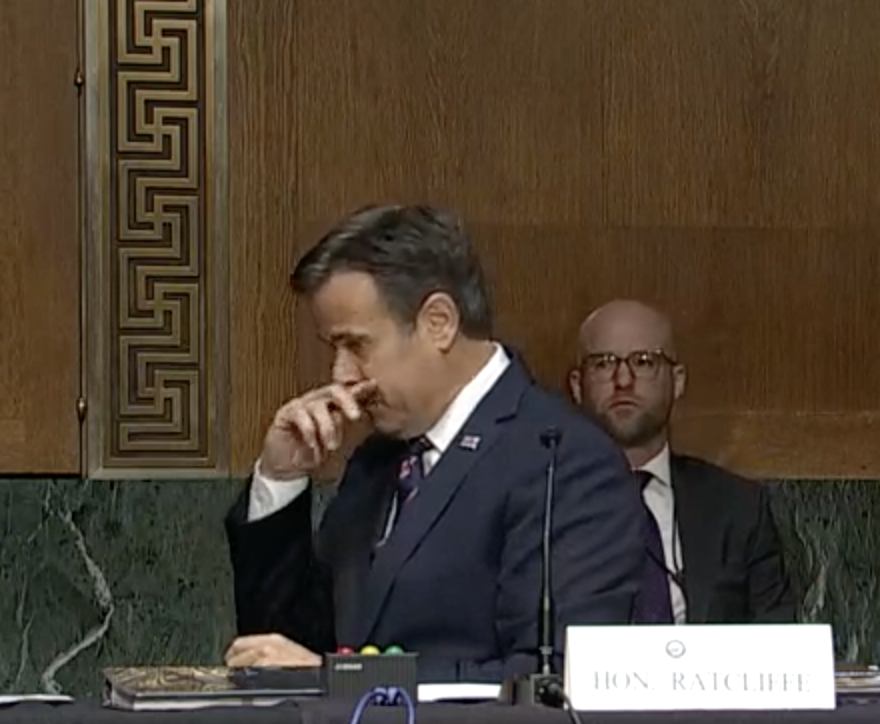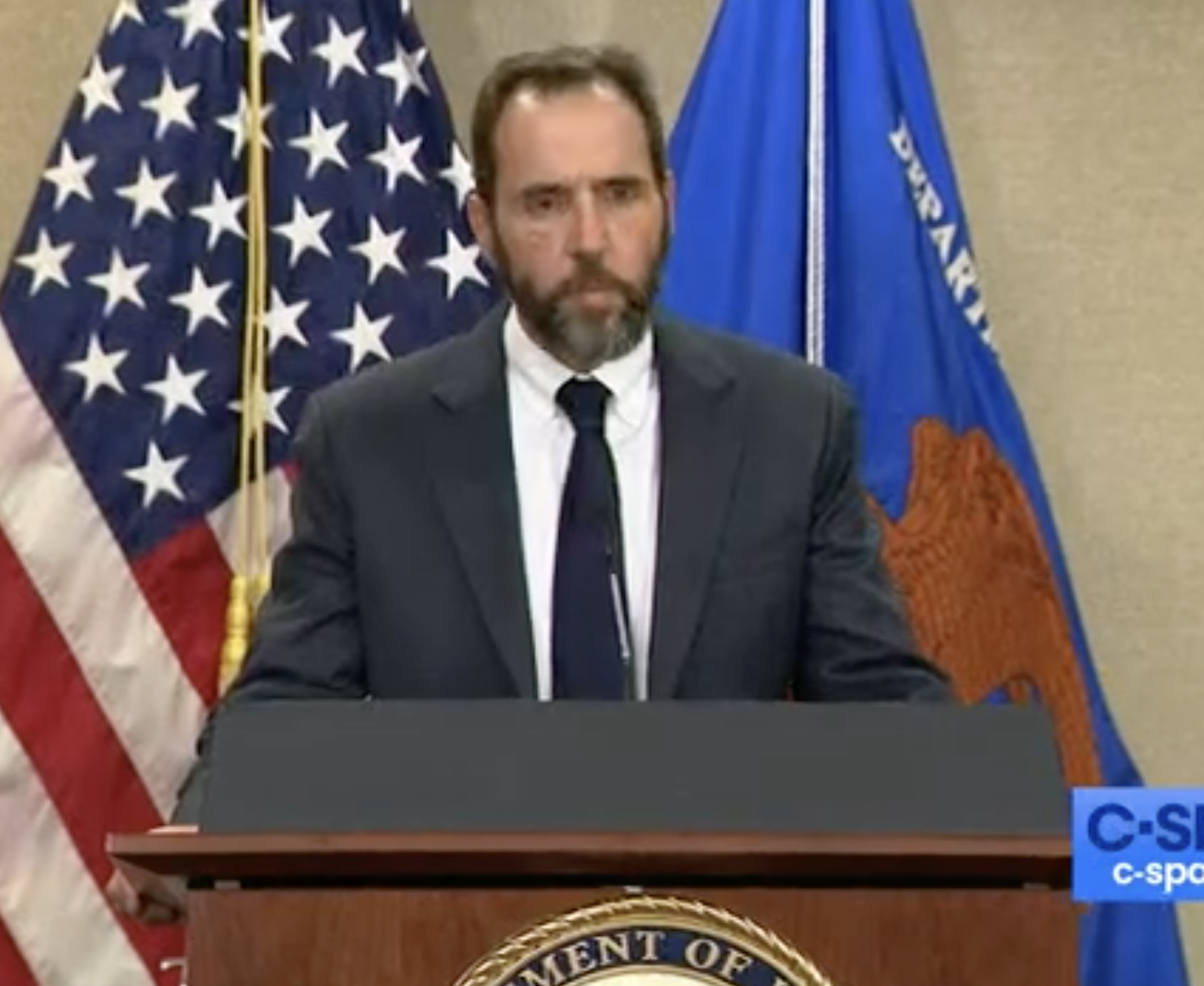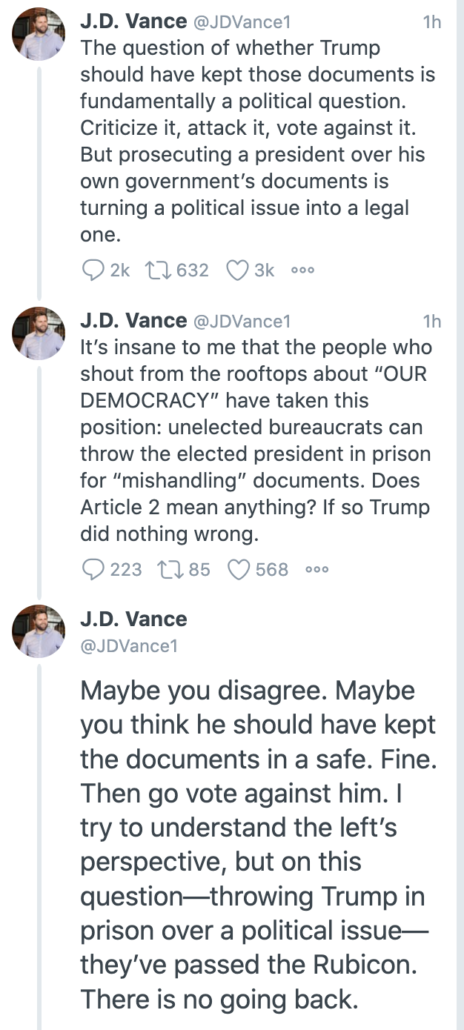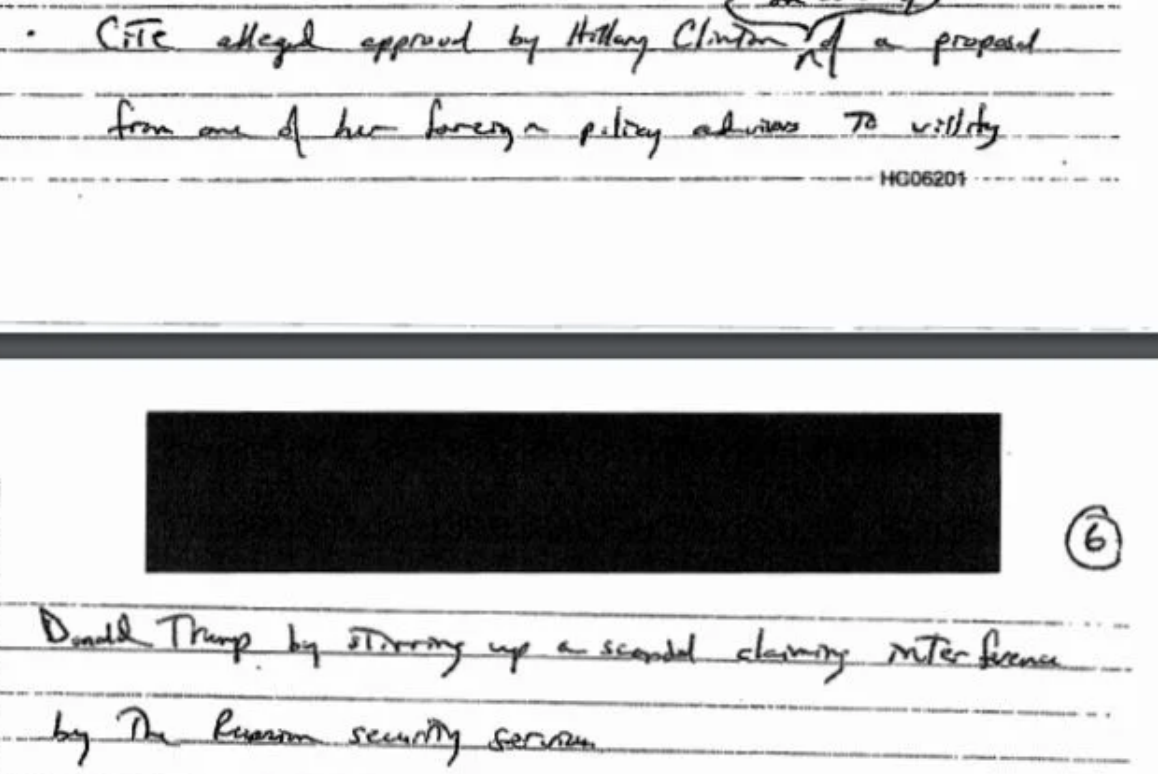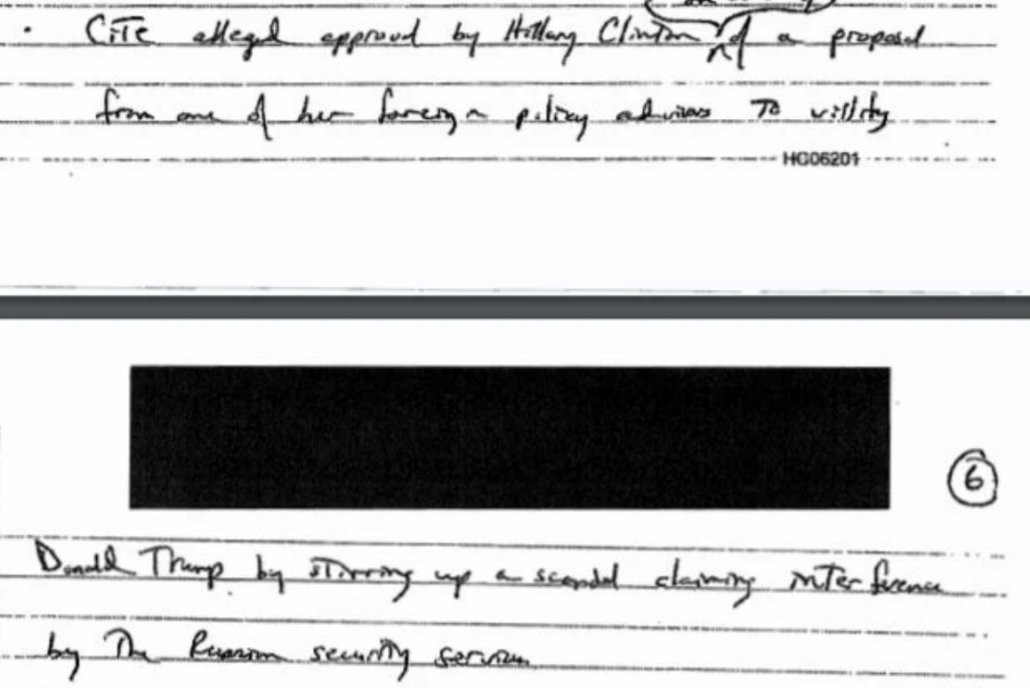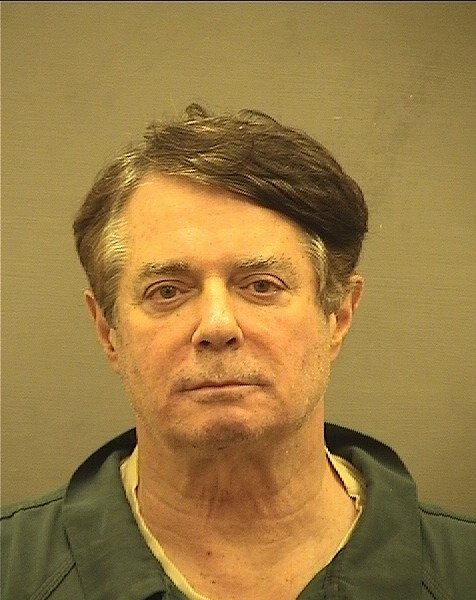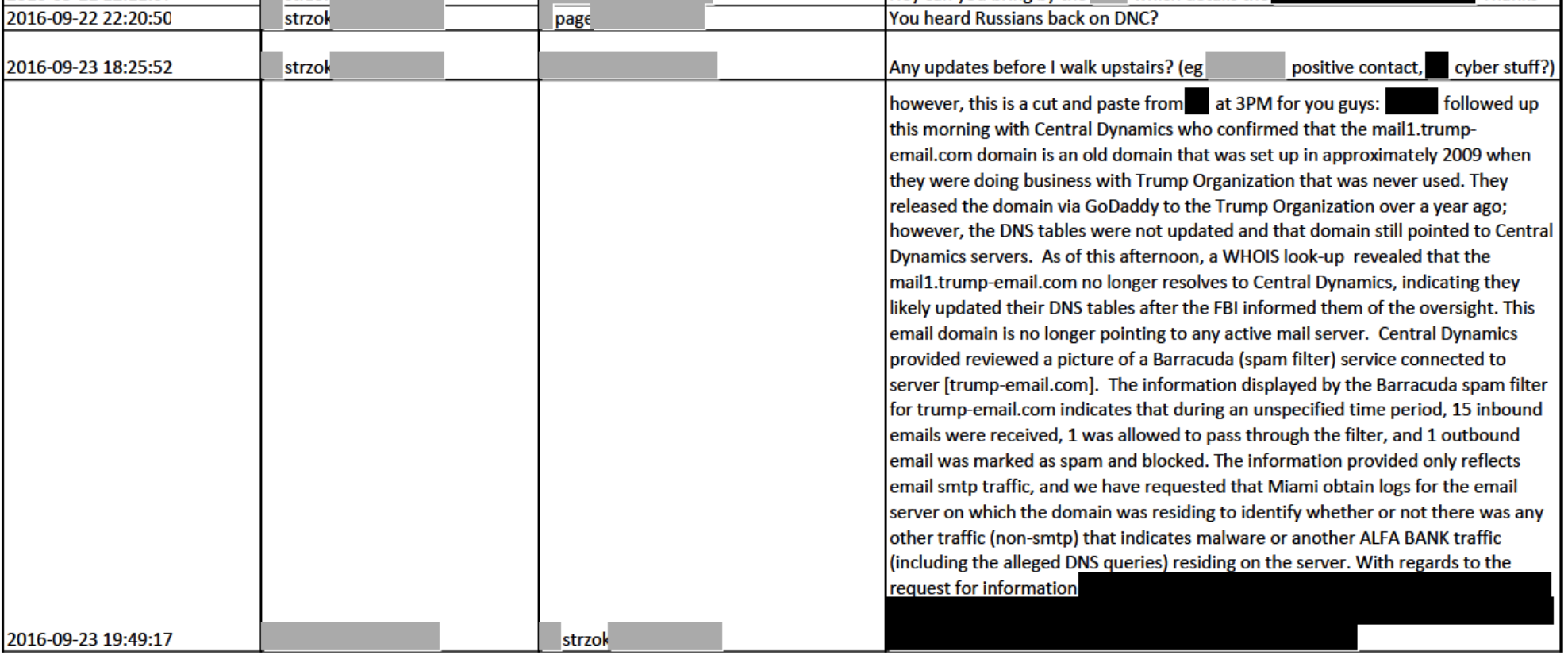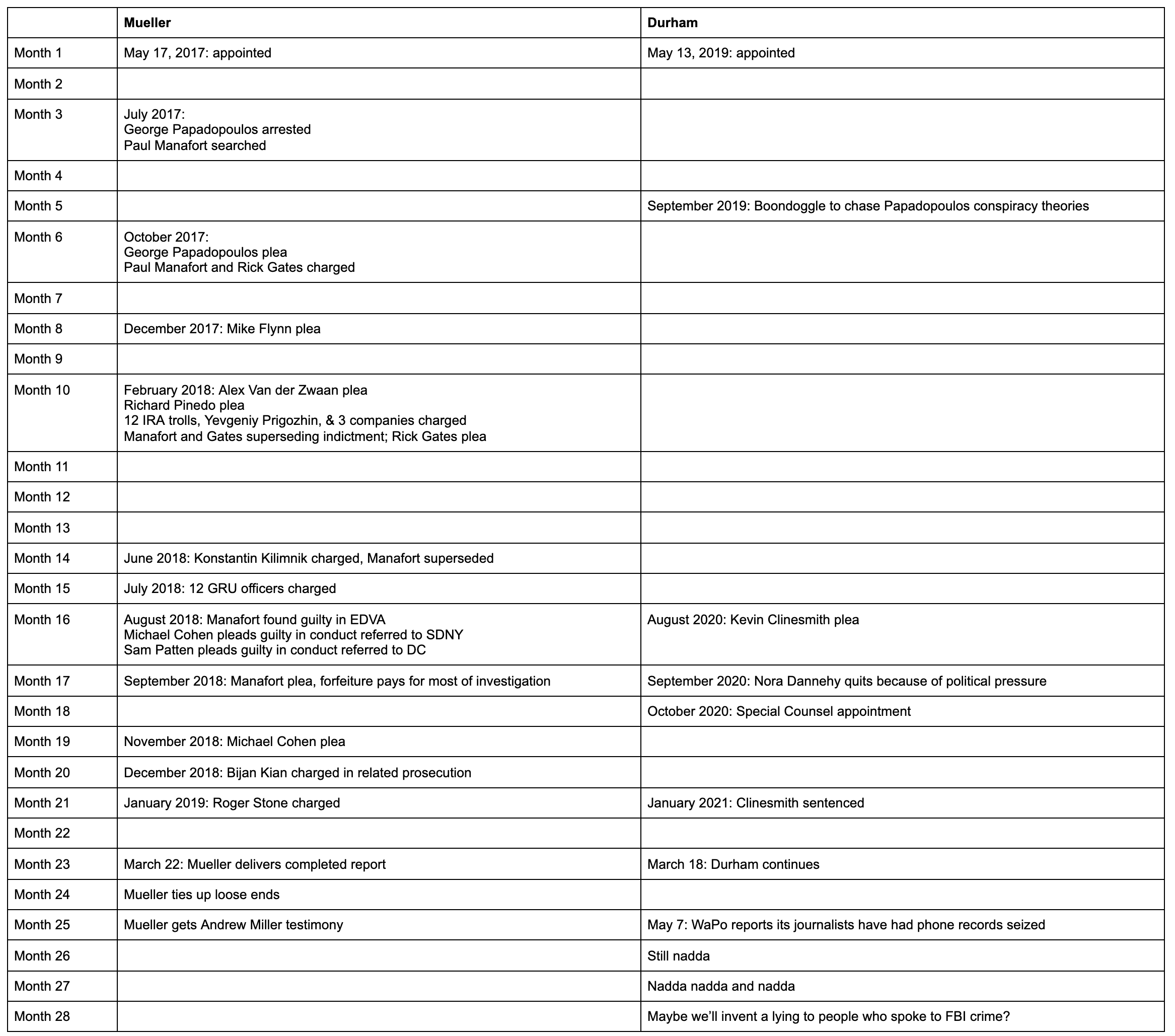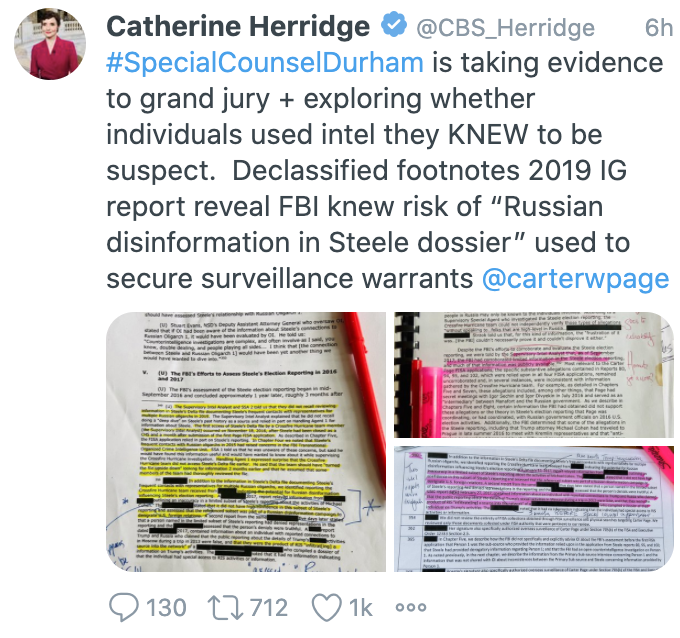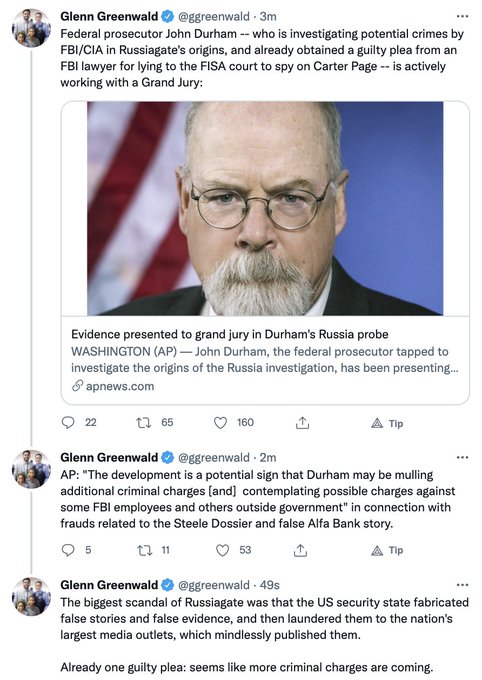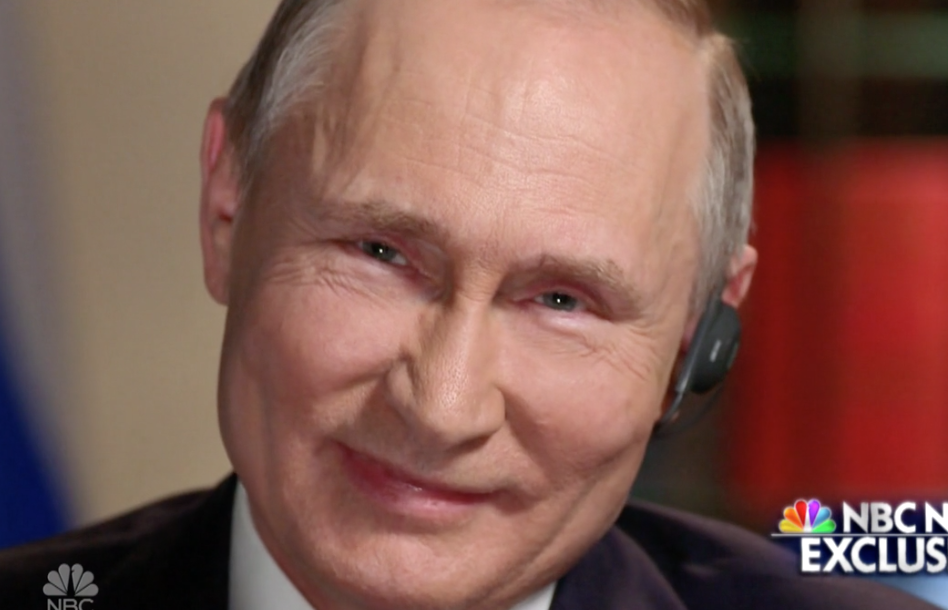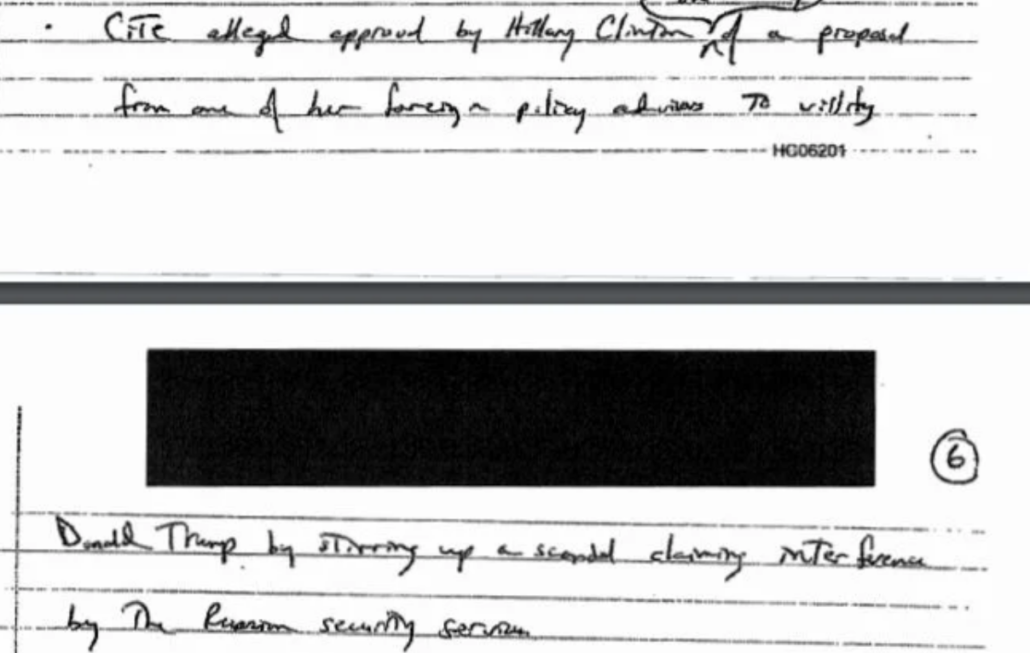John Ratcliffe and Kash Patel — and Durham Himself — Committed the Crime John Durham Was Hunting
By July 2021, John Durham had virtually all the evidence he needed to know that both premises of his investigation — that Hillary Clinton had a plan to frame Donald Trump, and FBI learned about that plan but ignored it when they relied on the Steele dossier and accepted the Alfa Bank allegations — were false. Yet he continued going for two more years anyway, pursuing prosecutions of Michael Sussmann and Igor Danchenko, both of which resulted in acquittals.
You might be forgiven, more than two years after John Durham closed up shop, if you’ve forgotten why he even spent four years chasing what is now clear was Russian disinformation, effectively investigating people because they had been hacked by Russian spies who framed them as part of a plan to, “put more oil into the fire.”
There are several explanations “why” Durham conducted this investigation, including:
- Bill Barr determined, before he even saw the evidence acquired by Mueller (if he ever did), there should be an investigation to avenge the Russian investigation
- Durham got snookered into chasing Russian conspiracy theories designed to stoke polarization, doing great damage in the process
- In 2020, John Ratcliffe reported a referral from the CIA to the FBI
Durham’s report misleadingly suggests it was the last one: the declassification of the SVR report that John Ratcliffe did — first a report about the SVR allegation, then two exhibits about it — in September and October 2020. By that point, Durham had done at least four interviews focused primarily on the SVR allegation: a September 17, 2019 interview with the FBI analyst who knew that collection best, a February 27, 2020 interview with some kind of spook, two July 8, 2020 interviews with some IC officers, and an interview with another IC officer the day Ratcliffe released the exhibits. (Given that Ratcliffe boasted about how many times he met with Durham, that October 7 interview could well be Ratcliffe himself.)
The Office also considered as part of its investigation the government’s handling of certain intelligence that it received during the summer of 2016. That intelligence concerned the purported “approval by Hillary Clinton on July 26, 2016 of a proposal from one of her foreign policy advisors to vilify Donald Trump by stirring up a scandal claiming interference by the Russian security services.” 391 We refer to that intelligence hereafter as the “Clinton Plan intelligence.” DNI John Ratcliffe declassified the following information about the Clinton Plan intelligence in September 2020 and conveyed it to the Senate Judiciary Committee:
- In late July 2016, U.S. intelligence agencies obtained insight into Russian intelligence analysis alleging that U.S Presidential candidate Hillary Clinton had approved a campaign plan to stir up a scandal against U.S. Presidential candidate Donald Trump by tying him to Putin and the Russians’ hacking of the Democratic National Committee. The IC does not know the accuracy of this allegation or the extent to which the Russian intelligence analysis may reflect exaggeration or fabrication.
- According to his handwritten notes, CIA Director Brennan subsequently briefed President Obama and other senior national security officials on the intelligence, including the “alleged approval by Hillary Clinton on July 26, 2016 of a proposal from one of her foreign policy advisors to vilify Donald Trump by stirring up a scandal claiming interference by Russian security services.”
- On 07 September 2016, U.S. intelligence officials forwarded an investigative referral to FBI Director James Comey and Deputy Assistant Director of Counterintelligence Peter Strzok regarding “U.S. Presidential candidate Hillary Clinton’s approval of a plan concerning U.S. Presidential candidate Donald Trump and Russian hackers hampering U.S. elections as a means of distracting the public from her use of a private mail server.” 392
The Clinton Plan intelligence was relevant to the Office’s investigation for two reasons.
First, the Clinton Plan intelligence itself and on its face arguably suggested that private actors affiliated with the Clinton campaign were seeking in 2016 to promote a false or exaggerated narrative to the public and to U.S. government agencies about Trump’s possible ties to Russia. Given the significant quantity of materials the FBI and other government agencies did in fact receive during the 2016 presidential election season and afterwards that originated with and/or were funded by the Clinton campaign or affiliated persons (i.e., the Steele Dossier reports, the Alfa Bank allegations, and the Yotaphone allegations), the Clinton Plan intelligence prompted the Office to consider (i) whether there was in fact a plan by the Clinton campaign to tie Trump to Russia in order to “stir[] up a scandal” in advance of the 2016 presidential election, and (ii) if such a plan existed, whether an aspect or component of that plan was to intentionally provide knowingly false and/or misleading information to the FBI or other agencies in furtherance of such a plan. 393
Second, the Clinton Plan intelligence was also highly relevant to the Office’s review and investigation because it was part of the mosaic of information that became known to certain U.S. officials at or before the time they made critical decisions in the Crossfire Hurricane case and in related law enforcement and intelligence efforts. Because these officials relied, at least in part, on materials provided or funded by the Clinton campaign and/or the DNC when seeking FISA warrants against a U.S. citizen (i.e., the Steele Dossier reports) and taking other investigative steps, the Clinton Plan intelligence had potential bearing on the reliability and credibility of those materials. Put another way, this intelligence-taken at face value-was arguably highly relevant and exculpatory because it could be read in fuller context, and in combination with other facts, to suggest that materials such as the Steele Dossier reports and the Alfa Bank allegations (discussed below and in greater detail in Section IV.E. l) were part of a political effort to smear a political opponent and to use the resources of the federal government’s law enforcement and intelligence agencies in support of a political objective. The Office therefore examined whether, and precisely when, U.S. law enforcement and intelligence officials became aware of the Clinton Plan intelligence; whether they vetted and analyzed the intelligence to understand its potential significance; and whether those officials, in turn, incorporated the intelligence into their decision-making regarding the investigation of individuals who were part of the Trump campaign and had possible ties to Russian election interference efforts.
I’ll come back to the significance of precisely what Ratcliffe and Kash declassified.
Durham depends on a different conspiracy theory in each report
For now, consider how each of his two volumes (unclassified, classified) confess that one of these two prongs — Clinton had a plan, and the FBI ignored that she did — was false, but then obscures that the other was, too.
This post, which explains Durham’s Clinton conspiracy conspiracy theory, holds up very well (if I do say so myself) even after the annex was declassified. It shows that Durham:
- Falsely claimed the Russian intelligence report alleging Hillary had a plan to smear Trump about his ties to Russia did — or would even have to — rely on false information
- Misrepresented the nature of the report about Hillary, thereby misrepresenting the dissemination of SVR intelligence within the Intelligence Community
- Only found any confirmation for his Clinton conspiracy conspiracy theory from witnesses whose memories had been radically altered by the threat of criminal prosecution; everyone else disclaimed every shred of Durham’s Clinton conspiracy conspiracy theory
There are just a few things structurally that seeing the classified annex adds. Here’s how the two sections map.
Both tell the story of the SVR Report (just the classified annex describes the underlying documents or concedes they were fabricated). Both describe how none of Hillary’s people knew anything about Durham’s Clinton conspiracy conspiracy theory. Both point to true things — reliance on an accurate Franklin Foer story that Durham miscites, interest in whether the FBI was investigating, and an effort to condemn Trump for his attacks on NATO — to bolster Durham’s case that his Clinton conspiracy conspiracy theory is true, though in the classified annex, Durham puts these details in his “The authenticity of the Benardo emails” section.
Both include a section that points to some other part of his (or the right wing’s) obsessions to bolster the Clinton conspiracy conspiracy theory. The unclassified report has a section that misrepresents both Fusion’s dissemination of the Steele dossier and Clinton’s media push of the Alfa Bank allegations (in the process, conflicting with other parts of his report and the results of his investigations) to buck up his theory. The classified annex has a section (after the conclusion that the emails were “composites” and a section describing other times the US Intelligence Community treated these SVR documents as authentic) pointing to Loretta Lynch’s “odd” reaction to a briefing on the two SVR reports claiming she was intervening in the Clinton email investigation. It’s the inclusion of that briefing (Durham conveniently ignores both that the FBI found these documents to be “objectively false” and the reference to Jim Comey throwing the election for Republicans) that allows Durham to decide that, while the emails on which the report was based were probably “composites,” the Clinton plan might be true (this is the conclusion Sean Davis and with him FBI Director Kash Patel cling to) and so his investigation into the FBI’s purported receipt of a report about it legitimate.
The other remarkable difference between the unclassified and classified report is in the way Durham describes his certainty that what he calls a referral ever got to the FBI — or more specifically, Peter Strzok — in the first place. His unclassified report includes an entire paragraph describing that no one on the Crossfire Hurricane team remembered seeing it.
The Office showed portions of the Clinton Plan intelligence to a number of individuals who were actively involved in the Crossfire Hurricane investigation. Most advised they had never seen the intelligence before, and some expressed surprise and dismay upon learning of it. For example, the original Supervisory Special Agent on the Crossfire Hurricane investigation, Supervisory Special Agent-1, reviewed the intelligence during one of his interviews with the Office. 428 After reading it, Supervisory Special Agent-1 became visibly upset and emotional, left the interview room with his counsel, and subsequently returned to state emphatically that he had never been apprised ofthe Clinton Plan intelligence and had never seen the aforementioned Referral Memo. 429 Supervisory Special Agent-1 expressed a sense of betrayal that no one had informed him ofthe intelligence. When the Office cautioned Supervisory Special Agent-1 that we had not verified or corroborated the accuracy of the intelligence and its assertions regarding the Clinton campaign, Supervisory Special Agent-1 responded firmly that regardless of whether its contents were true, he should have been informed of it. 430
During Durham’s testimony to Congress, Strzok revealed that 1) contrary to Durham’s insinuations, he had spoken with with Durham’s investigators and 2) the copy of the referral that Durham’s team showed him was not an FBI copy, suggesting that Durham also had no proof the document ever made it to the FBI.
So in the unclassified report, Durham confesses his entire premise — that the FBI received this report and didn’t respond as he thinks they should have — may be utter bullshit, because they never received it.
Yet in his classified report, he states as fact, three different times, that it was sent to the FBI. He says this twice in the section purporting to validate the import of this report because the Intelligence Community responded to it, section 4 above.
In addition, as described in the unclassified report, on September 7, 2016, the CIA sent the FBI an “investigative referral” memorandum that referred to, among other information, the purported Clinton campaign plan.
[snip]
The DNI also declassified a portion of former CIA Director Brennan’s handwritten notes that describe the August 3, 2016 meeting with President Obama and the CIA Referral Memorandum sent to Director Comey and Deputy Assistant Director of Counterintelligence Peter Strzok. [my emphasis]
And then in the conclusion — the one Davis is impressed with — finding that even though the email on which this conspiracy theory was based is a composite, nevertheless it was important because the CIA sent a referral memo that he falsely suggests actually arrived at its destination.
Moreover, in early September 2016, the CIA prepared a referral memorandum on the information regarding the purported “plan” that went to the FBI [my emphasis]
So looking at these two together, the classified annex concludes that the emails behind the report that launched this whole project are “composites,” but because the CIA sent the FBI a referral memo, argues it was a legitimate exercise to review how the FBI responded to that referral memo. Then the unclassified report concedes it has no proof the CIA referral ever made it to the Crossfire Hurricane team, but the investigation was legitimate because Clinton may have shared knowingly false allegations about Trump with the FBI.
John Ratcliffe committed the crime John Durham was hunting
Now consider how those Ratcliffe declassifications cabined the investigation.
He describes that in interviews with Clinton and FBI people (to the extent that he’s not covering up FBI interviews that don’t help him), he used the declassified files with people who lacked clearance (including, with Jennifer Palmieri, the referral document rather than the report itself) and used a redacted version of the emails with people who had clearance, as well as Leonard Benardo. So his question about “Clinton plan” all focused on how fevered right wingers defined it.
I’ve already talked about the blind spots built into John Brennan’s notes. These notes span the fifth and sixth pages of Brennan’s notes, meaning a whole lot of the briefing was more important. They’re described as offering insight into “Russian activities,” not Hillary’s (the CIA couldn’t investigate Hillary’s in any case). The first redacted paragraph likely describes the SVR targets in question.
But there’s a bullet before the description of the purported Hillary plan, and who knows how much after it.
Now check out where the word, “vilify” appears in the known SVR documents. The actual draft report — the purported subject of this investigation — used the word, “smear.” The two emails dated July 25 using a Russian idiom, along with the email between spooks discussing starting a conspiracy theory, use the word, “demonize.” The purported July 27 email from Benardo doesn’t use any such word.
The word “vilify” appears in this email between spooks — the one that follows the one in which they discuss a plan to start a conspiracy theory about the Deep State.
Even in the classified appendix, Durham provides very little of the email, and half of what is there is redacted.
Now look at the referral memo.
It refers to “an exchange,” not a draft memo, which is what the memo in question is. It’s hard to imagine, at this point, what could be behind that redaction about Guccifer. And while there’s a mention in the report itself to Guccifer, that doesn’t pertain to Hillary. It’s a claim about what the FBI has discovered:
Clinton’s supporters in the FBI lack conclusive irrefutable evidence of the Russian Federation’s involvement in the scandal, tied to the theft of the DNC’s correspondence. In the meantime, during the launched investigation, there has been a multitude of circumstantial evidence that the alias of Guccifer 2.0 (the name of the hacker who accepted responsibility for the incident) was, in fact, used to cover up a special unit of the GRU of the Russian Federation Defense Ministry’s General Staff.
The email between the two spooks — which could fairly be called “an exchange” — ties the attribution to Guccifer directly to the plan to start a conspiracy theory about Hillary.
Effectively, this exchange says, “fuck, they’re onto Guccifer, let’s start a conspiracy theory about Hillary! dark forces!! Deep State!!!” And then the follow-up email describes the conspiracy theory in terms of “vilifying” Putin and Trump.
Both these reports — the Brennan notes and the CIA referral to FBI — appear to refer not to the draft report about Hillary’s claimed plan, but instead to communications between the Russian spooks reflecting a plan to invent a conspiracy theory about Hillary to muddle the Guccifer attribution (which is precisely what Roger Stone immediately did).
If that’s right, it means it was never a Clinton plan, it was an SVR plan. That makes sense; after all, John Brennan wouldn’t be permitted to investigate Hillary Clinton’s plans to do oppo research, but he would be permitted to investigate SVR’s plans to frame Hillary. And that’s what he told Durham: he was focused not on Hillary’s plan but Russia’s.
When interviewed, Brennan generally recalled reviewing the materials but stated he did not recall focusing specifically on its assertions regarding the Clinton campaign’s purported plan. 400 Brennan recalled instead focusing on Russia’s role in hacking the DNC. 401
And having apparently mischaracterized what actually elicited CIA attention, Durham then spent paragraphs and paragraphs talking about how if the FBI had simply factored in a conspiracy theory invented by SVR to muddle the GRU attribution, then they might not have relied on the Steele dossier (itself being injected with Russian disinformation) or accepted the Alfa Bank allegations.
Indeed, Durham actually considered whether Peter Strzok committed a crime by ignoring his misrepresentation of the referral that he had no evidence Strzok ever received.
Whether these failures by U.S. officials amounted to criminal acts, however, is a different question. In order for the above-described facts to give rise to criminal liability under federal civil rights statutes, the Office would need to, for example, identify one or more persons who (i) knew the Clinton campaign intended to falsely accuse its opponent with specific information or allegations, (ii) intentionally disregarded a particular civil right of a particular person (such as the right to be free of unreasonable searches or seizures), and (iii) then intentionally aided that effort by taking investigative steps based on those allegations while knowing that they were false.
[snip]
Although the evidence we collected revealed a troubling disregard for the Clinton Plan intelligence and potential confirmation bias in favor of continued investigative scrutiny of Trump and his associates, it did not yield evidence sufficient to prove beyond a reasonable doubt that any FBI or CIA officials494 intentionally furthered a Clinton campaign plan to frame or falsely accuse Trump of improper ties to Russia.
But Durham never factors into his own investigation those other two emails between spooks, both of which likely precede the report he claimed he was investigating. He never mentions them at all. Had he factored those in, all of this would have been shut down in 2021.
And after claiming that Clinton had a plan to falsely accuse her opponent rather than that SVR had a plan to falsely accuse Hillary, Durham used all this to get warrants targeting Michael Sussmann and Igor Danchenko. He, “intentionally disregarded a particular civil right of [Sussmann and Danchenko] (such as the right to be free of unreasonable searches or seizures), and (iii) then intentionally aided that effort by taking investigative steps based on those allegations while knowing that they were false.”
Once you see those two other emails between the Russian spooks — the one linking Guccifer directly to the plan to talk about the Deep State and the one using the word “vilify,” both of which Durham disregarded — then you have evidence that Kash, Ratcliffe, and Durham himself knew the SVR intended to falsely accuse Hillary, then took investigative steps based on those allegations that were clearly fabricated.
They took four whole years of investigative steps.
No wonder Durham allegedly tried to bury all this in burn bags.
Update: Remember that Kash, at a time he was a private citizen, was making claims making insinuations about Hillary making a plan in July 2016.
Update: And Ratcliffe was similarly making false claims on this topic while a private citizen.



